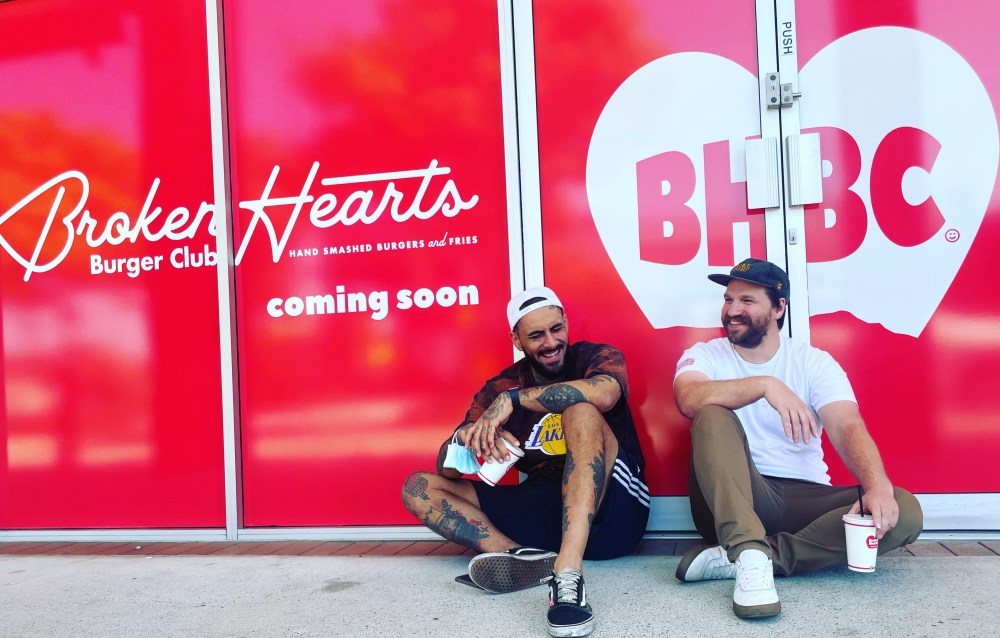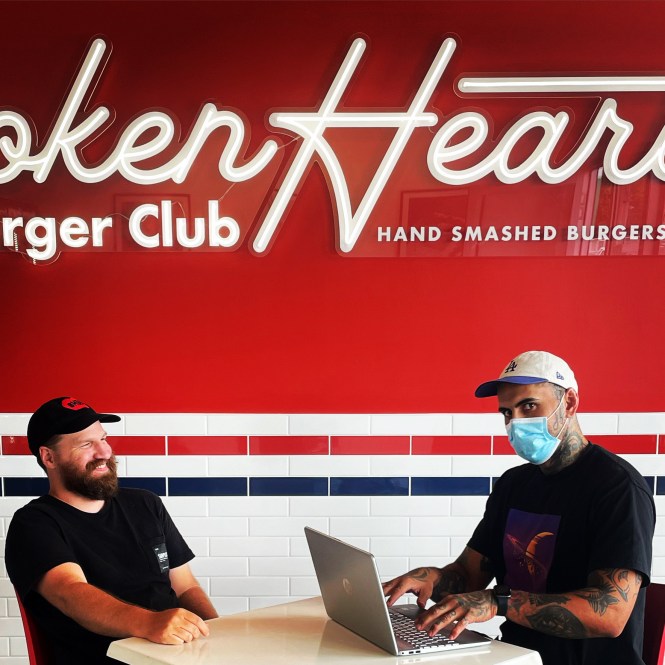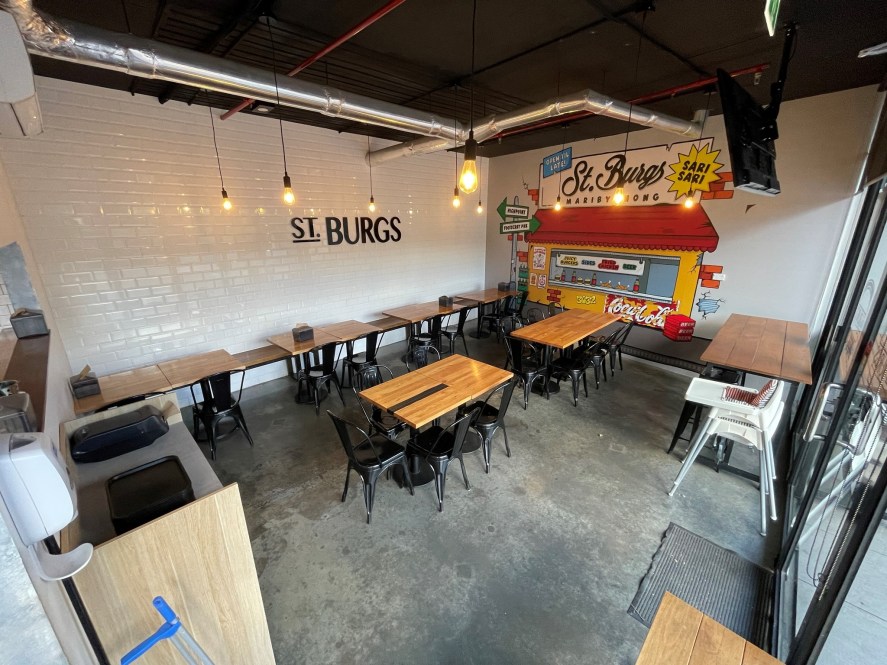The Americans invented the hamburger, so it makes perfect sense its kin was created on the same lands. The smash burger gets its name from the technique used to create it, with the first iteration incepted in Kentucky some 60 years ago. A restaurant worker crushed a meat patty on the grill with a bean can to maximise the flavour of the meat.
Now, there are burger chains, pop-up vendors and food trucks that revolve around the smash burger, which has enjoyed an evergreen status since its creation. In Australia, smash burgers have yet to crack the mainstream, with most diners unaccustomed to its signature thin patty and small stature. But word has started to spread, and early adopters have set a high bar for what’s to come.
Hospitality speaks to Broken Hearts Burger Club’s Jay Gordon and St. Burgs’ Dan Soto about why they decided to launch smash burger businesses, the defining characteristics of the creation and how they’ve helped start a new chapter for the local burger scene.
A trip to Los Angeles isn’t complete without a stop at In-N-Out Burger. The fast-food chain is known for simple-but-done-well burgers, and the same notion can generally be applied to burgers in the United States — no matter where you go, it’s hard to get a bad one.
Jay Gordon made the most of the LA burger scene during his time living in the city,
immersing himself in the best the area had to offer. “I was deep into the street scene; guys set up on the side of the road at Venice Beach and cook the burgers in front of you,” he says. “They all use different meat blends and then recommend six other places for you to try. It’s a really cool burger culture.”
Gordon returned to Brisbane at the start of 2020 and found there was a serious lack of smash burgers around, so he took matters into his own hands. “When I came back, I didn’t have a job here and I had nothing to do,” he says. “I was missing the burgers in the States, so I began making them and trying to perfect the technique. Tripp Burgers [Mark Tripp] helped me out with the blend and whatnot.”

Peer Review Burgers (soon to become Broken Hearts Burger Club) got its start by bringing a little joy to life in lockdown, with Gordon delivering burgers to people who were stuck in quarantine. But things fast snowballed beyond that framework. “The Instagram account went from 50 to 1,000 followers,” says Gordon.
“A friend of mine got involved and then we did three pop-ups. The first sold out in 11 hours and we pre-sold all the burgers. The second sold out in 11 minutes and the third sold out in two minutes. We opened the Broken Hearts Burger Club shop [in Morningside] and it’s been go, go, go ever since.”
It’s a story echoed by Dan Soto, whose trip to the US went on to become a life-changing experience. “When I got back to Melbourne, I was on a burger hunt for something on the same level,” he says. “I found a few places, but they would change their menus, so I thought I’d try and make smash burgers at home.”
After a number of attempts, Soto put his smash burger in front of some tough critics — his family and friends. “The feedback was really positive, so I started doing pop-ups at my friends’ businesses,” he says. “Then I approached my brothers to be a part of it and they jumped on board.”
A backyard idea resulted in the launch of St. Burgs, which now has locations in Maribyrnong and Caroline Springs in Victoria. So what exactly is a smash burger? The defining characteristic is of course, the patty. “Put simply, the burger originates as a ball of meat that goes onto a hot griddle and it gets smashed,” says Gordon.
For Soto, it’s all about the crust. “When I went to the US, I didn’t know what a smash
burger was,” he says. “I was like, ‘What’s different about it?’ There’s a crust on the patty and it’s crispy, but when you bite into it, it’s juicy inside. It’s an ‘if you know, you know’ type thing.”

A typical smash burger patty comprises a mix of beef cuts, often chuck, sirloin or brisket. While it seems simple, getting the right balance of fat and meat involves plenty of trial and error. “It took around eight months to develop,” says Gordon.
“When we started, we were making burgers every day and people would give us feedback. We tried different meat blends and finally got to the one we settled on. Our blend has sirloin which makes it moreish and a little bit of bacon, which changes the way it responds to heat on the griddle. You see the way it emulsifies versus straight beef.”
Broken Hearts Burger Club has taken the grinding process into their own hands after teaming up with a butcher, who worked with their existing supplier, to launch High Stakes Grinding Company. “When he would grind the meat himself, it was absolutely perfect,” says Gordon. “We are pedantic on consistency — our entire brand is basically one burger — and our first store was going ballistic, so we set up a commercial butcher. We are also supplying meat to competitors, but all the blends are protected.”
St. Burgs’ meat blend took around a year to develop, with Soto testing out both grain- and grass-fed beef. “It took me a while to get it right,” says Soto. “It’s very important to get the perfect blend and fat ratio; we do 70:30.”
While the recipe is kept under wraps, Soto confirms chuck is involved. “The typical beef blend is chuck/brisket 80:20. But you need to get the grind right; you don’t want it to be too chunky or too fine. If it’s too fine, it has a sausage texture and if it’s too chunky, it becomes chewy when you smash it.”
One of the best parts about cooking smash burgers is that they can be made in a matter of minutes. The main pressure point is monitoring the temperature of the griddle, which comes down to experience and how many orders are coming in. Gordon and the team tried to use timers at one point, but “the cool spots, rebound rate and heat of the griddle made it a bit of a fool’s errand”, he says. “The griddle can get hot when it’s not constantly hit with meat and cools down when we’re throwing down 25 patties at a time.”

Instead, the team follows this process: “We smash the patties super thin and watch them until there are a few bubbles on top like a pancake,” says Gordon. “We flip and there’s a great crust — but you don’t want a crust on both sides, otherwise you’ll burn it to a crisp. We put the cheese on, which melts rapidly, and then we take it off.”
Over at St. Burgs, the grill is set to a medium–high heat to ensure the patties don’t stew. “There’s a certain technique — the patty has to stick to the grill and have a Maillard reaction to form a crust,” says Soto.
“You can have the meat rolled into balls or pressed into a patty shape. I smash it quickly with a steel 2kg burger mallet instead of the original technique, which uses a steel spatula to push it down. Once you smash it, I flip it within a minute and put the cheese on, taking it off once it’s slightly melted. I like to have crisp edges and keep it pink in the middle. Basically, you treat it like a quality piece of steak — you don’t want to overcook it.”
A bun can make or break a burger — it doesn’t matter how great your meat blend is, if it doesn’t hold together, it’s a bust. “To be a smash burger, it’s the meat and how you smash it, but we spent an insane amount of time on the bun,” says Gordon.
Broken Hearts Burger Club developed a bespoke bun with a local baker that takes cues from the iconic Martin’s potato roll. “We use a potato bun that’s a bit bigger than the Martin’s roll,” says Gordon. “The size is a concession we made for the Australian market.”

The top bun is slathered in butter and wet toasted during the assembly process. “It rides on top of the stack of beef and soaks up the steam — grease is the condiment,” says Gordon.
“The bottom half gets ‘doped’ with sauce and salads, and in our process, the toppings go under the beef and cheese. These aren’t things we invented; it’s what I learned in LA from Mark Tripp and is the genealogy of burgers.”
A milk bun is the vessel of choice at St. Burgs, and was selected for its favourable traits. “Milk buns stay soft for a while and they’re not so heavy,” says Soto. “They’re slightly sweet so they balance out the saltiness of the burger. Plus, you can max out on four patties.”
When it comes to toppings, both venues keep things simple, which is in line with how a smash burger should be enjoyed. “We have two burgers, and they’re really the same; but the Fancy has lettuce and tomato,” says Gordon. “The classic is just a cheeseburger with American cheese, pickles and special sauce, and that’s the entirety of our menu besides fries.”

The Double D is St. Burgs’ best-seller on the original menu, which sees Gippsland grass-fed beef patties combined with two slices of American cheese, bacon, lettuce, tomato, gherkin relish, burger mayo and smoky sauce.
“It’s not too big or too small, and I think it’s a really well-balanced burger in terms of sweetness and savouriness,” says Soto. “A person can comfortably eat it and not feel too guilty.”
It’s safe to say the days of monster burgers are well and truly behind us, and a new chapter has been ushered in — one built on simplicity and growing a community. “The thing we’re trying to promote in Australia is a burger scene,” says Gordon. “Everyone does better when you’re promoting the scene rather than competing with each other. I want there to be a place a few corners away that’s open 24 hours where I can get a simple burger. If we go bust and that’s all I achieve, then I have succeeded.”
While the presence of smash burgers has increased in recent years, they still have that new-car smell. “Smash patties have a long way to go in terms of becoming renowned here; it’s still early days,” says Soto. “Some customers are like, ‘The patties look weird, why do they look like that?’ And I’m like, ‘Trust me, have a bite and you won’t regret it’.”
Sponsored Content

The future of the commercial kitchen is electric
Sponsored by Comcater

How a cyberattack brought a hospitality group to a standstill
Sponsored by BizCover
Trending Now
Resources
Lorem ipsum dolor sit amet, consectetur adipiscing elit. Fusce ac ornare lectus. Sed bibendum lobortis...
Lorem ipsum dolor sit amet, consectetur adipiscing elit. Fusce ac ornare lectus. Sed bibendum lobortis...
Sign up for our newsletter
